Winter begonia care at home
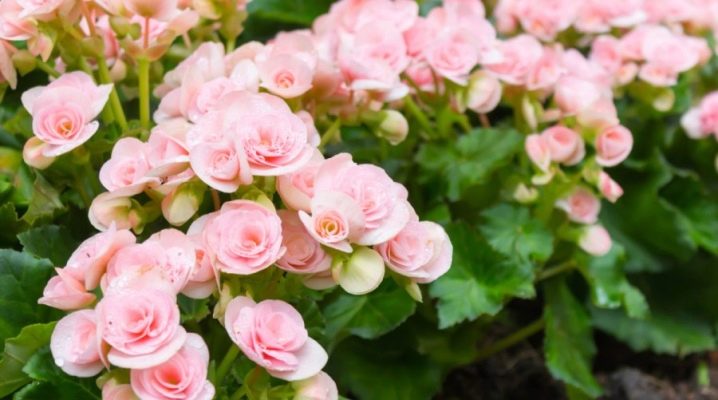
Begonia is a plant that has certain characteristics of life in winter. Taking proper care of the flower at this time will keep it in good condition. Let's take a closer look at how to properly care for this plant at home.
Features of winter care
Begonia is a plant that is constantly growing, with virtually no period of absolute dormancy. Favorable external conditions are essential for the flower to "feel" well in winter. An indicator of such well-being is the bright color of its leaves. If the color of the foliage changes, then this indicates that the plant is getting sick.
Begonia tolerates wintering quite well. A flower hibernates without any negative consequences only if it is properly looked after. So, in order for begonia to grow well, in the room where it is located, it is imperative to maintain certain microclimate indicators. The temperature regime in winter for begonias is important. In the cold season of the year, the plant does not require high temperatures. Experts recommend changing the temperature mode a little. This will keep the plant in good condition.
During the winter period of the year, you should also monitor the regularity of watering. Begonia needs moisture. However, over-watering can cause the plant to get sick with fungal diseases.
Another important metric to watch out for is humidity. Due to the fact that heating devices work in the room in winter, this indicator of the microclimate changes. So, too dry air in the apartment can lead to the fact that begonia leaves lose their natural turgor. Plant care specialists recommend moving this ornamental plant away from a heater (such as a radiator) in winter. This will help reduce the risk of developing possible leaf damage.

Fundamental rules
Taking care of indoor begonias in winter is quite simple. At the same time, experts recommend that you still prepare in advance for winter. So, the plant is recommended to be transplanted (if required) before the onset of cold weather. This will protect the plant's root system from damage, and will also not interfere with its further good growth.
Proper care of this plant depends on its variety. There are quite a few varieties of this flower. For example, tuberous begonias can be grown both on your own windowsill and in the open field. It is recommended to dig out garden tuberous plants from the soil at the end of November. In this case, it is imperative to cut off the remnants of the shoots. It is recommended to do this in such a way that the remainder of the cut off shoot is no more than 1.5-2.5 cm.
After the begonia tubers are processed in this way, the remains of the soil substrate must be removed from them. After that, they should be placed in storage. It is recommended to store the dug tubers in a well-ventilated room. This is necessary so that rot does not appear on them. This thorough drying time should be 2 weeks. After that, the dried begonia tubers can be transferred to a box for further storage. In the room where they are located, the humidity should be 75-80%, and the temperature should be + 10-12 degrees Celsius.
If this tuberous plant is not in the open ground, then in this case it is not necessary to remove it from the pot for the winter. During this time, it is very important that the begonia is in a comfortable environment. In winter, it is recommended not to transplant and propagate the tuberous indoor begonia. And if the pot with the plant is in a too cold room, then it is better to insulate it a little. This will reduce possible damage to the root system.
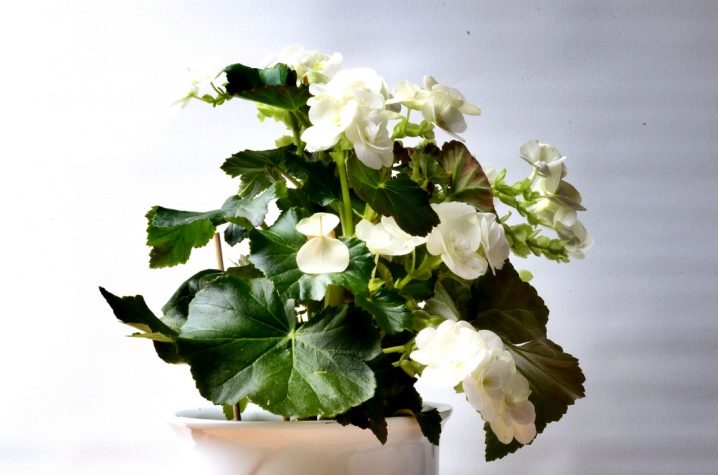
Watering
In the winter season, this plant does not require frequent watering. Do not allow it to dry out either. Insufficient moisture supply can damage the root system. If liquid accumulates in the soil substrate, then pathogens may appear there. If heating devices work in the room, then in this case the flower needs more frequent watering. You can determine whether a flower needs watering by touching the ground with your finger.
Experts recommend watering this ornamental plant when the soil substrate is dry 1-2 cm from the surface.

Temperature regime
In winter, indoor begonias do not need high temperatures for good growth. Experts recommend to slightly reduce this indicator during the cold period. So, in order to maintain good vital activity of the flower, it is recommended to lower the temperature to + 15-16 degrees Celsius. If you cannot create such a temperature regime in winter due to the active operation of heating devices, then in this case, you should definitely monitor the regularity of watering. It is believed that at a temperature of + 22-25 degrees, it is necessary to water the plant more often. Experts note that in winter, even with a change in temperature, begonia may look somewhat different than in summer. For example, the leaves of a plant become less bright, acquire a pale color. It is also possible to change the shoots of the plant.
Due to the change in the length of daylight hours, the shoots may stretch slightly in length.
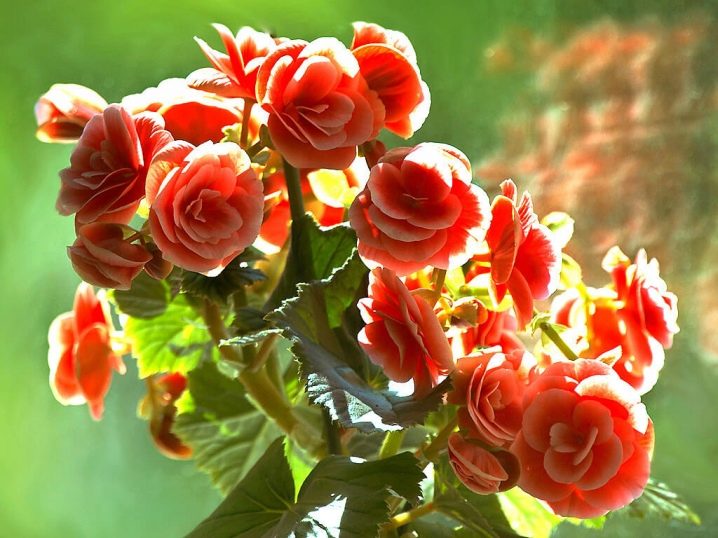
Humidity
Since the heating devices are turned on in winter, the air in the room becomes too dry. To avoid damage to the flower, it is recommended to maintain a certain humidity in the room - 70-80%. It is not worthwhile to allow this indicator to decrease too much, as this may cause the foliage of the flower to become less bright.
If the humidity in the room decreases, then in this case it is necessary to increase it. Home appliances - humidifiers - can help with this. If there is no such device in the house, experts recommend spraying indoor air. This should be done so that drops of moisture from the spray bottle do not fall directly on this flower. It is better to spray at a short distance from the plant.
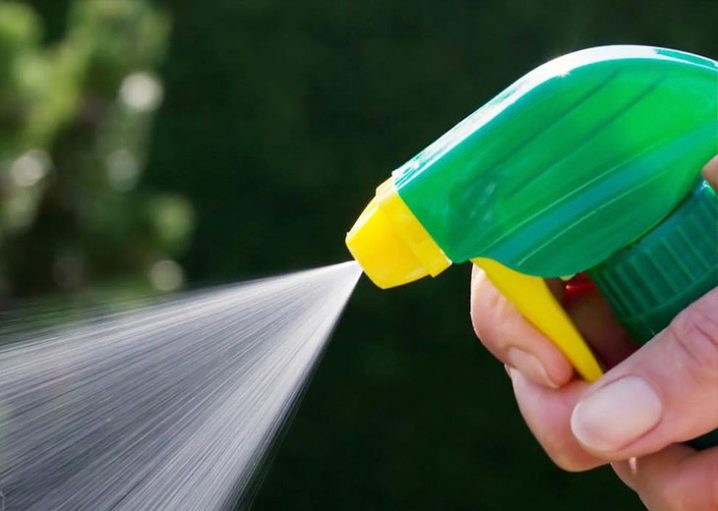
Lighting
In winter, insolation decreases. This certainly has an effect on ornamental plants. If there is very little sunlight, the leaves begin to fade. Experts recommend in this case, be sure to think about changing the lighting. To do this, they advise moving the plant closer to the window.
You can remove begonia from the windowsill for the winter if it blooms. During the flowering period, this ornamental plant does not need a lot of light. And also at this time it is very important that the scattered sunlight falls on the flower. Direct sunlight can negatively affect the condition of begonia leaves.

Top dressing
In winter, mineral fertilizers should not be enriched in the soil in which the begonia is located. It is recommended to feed a decorative flower only in the spring, when it begins to grow more actively.
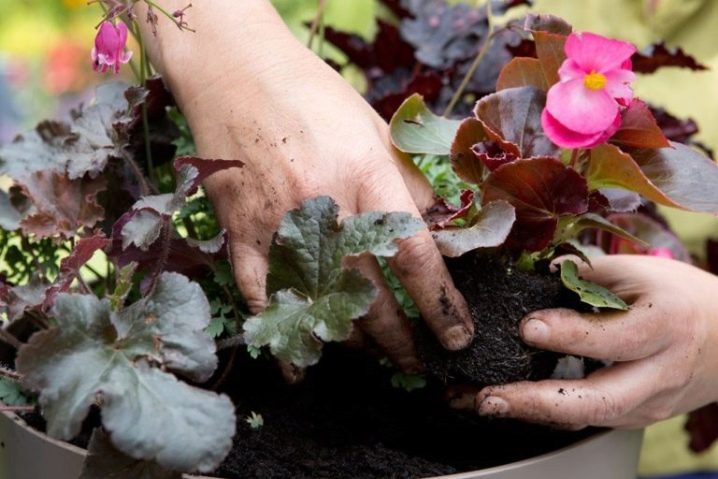
Pruning
Many people who have begonias in their home are interested in the question of whether it is necessary to prune them in the winter. Experts say that you should refrain from this procedure in winter.They note that if the foliage of a given plant remains in good condition, then it is not worth pruning it in winter.
Possible problems and diseases
In winter, begonia is quite vulnerable to various diseases. The risk of such diseases increases significantly if flower care is carried out incorrectly. One of the fairly common problems that are recorded in begonias in winter is severe dryness of the edges of the leaves. In this case, the damaged leaf may even curl into a tube. Lead to the fact that begonia practically withers in a pot, as a rule, a decrease in humidity in the room and an uncomfortable temperature for the plant. Experts in this situation, when begonia grows poorly, recommend moving the plant to another place. If the decorative flower stood on the windowsill at the same time, then it should be removed to a less illuminated place.
Improper watering can cause fatal damage to begonias. Plants die at the same time due to the fact that the root system is significantly damaged. If water has accumulated in the pan with the pot where the flower is located, then the moisture must be removed immediately. In this case, the frequency of watering should be reduced.
A change in the turgor of the leaves can be caused by the fact that the flower is quite close to the plate. Such a problem occurs quite often in winter also because, in addition to household appliances, heating ones also work. This, in turn, contributes to changes in humidity and temperature in the room, which leads to the fact that the begonia leaves begin to wilt. In this case, the flower looks drooping.
Experts recommend in such a situation to urgently move the ornamental plant from the kitchen to another room.
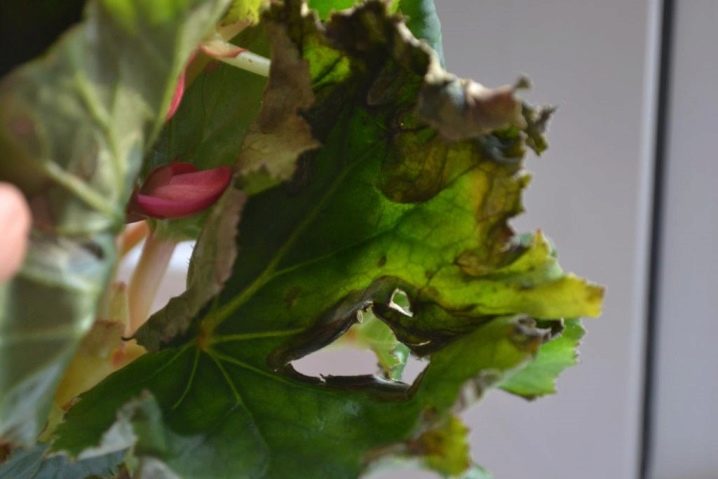
With the onset of unfavorable conditions, begonia can get sick. One of the diseases of this decorative flower is rot that develops on the stems or roots. The appearance of such manifestations on the plant is largely facilitated by the stagnation of moisture in the soil substrate. In such a situation, experts recommend that you definitely reduce the frequency of watering the plant, as well as measure the humidity in the room where it is located.
Heavy leaf fall is another problem that begonias lovers can face in winter. It can be quite difficult to "force" a flower to have luscious green leaves all year round in some situations. Experts note that if the leaves of this decorative flower began to fall off strongly, then in this case it is recommended to pay attention to where it is. Quite often, wind-induced hypothermia of the leaves contributes to the appearance of this problem. This is often the result of finding begonias on a blown windowsill. If the leaves of the ornamental plant began to fall off strongly, it is recommended to remove it away from the window, and also protect it from any drafts.
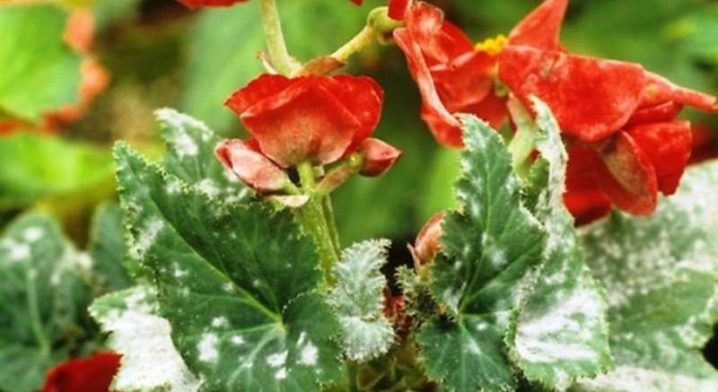
The appearance of yellow spots on the leaves of begonia and a change in its turgor is one of the possible diseases that can be detected in this plant. Cucumber mosaic viruses can lead to such adverse symptoms. It is rather difficult to cure a plant affected by these microbes at home. In this case, the diseased flower should be immediately moved to "quarantine", otherwise it can become a source of spread of infection to other plants.
Begonia, like many other indoor plants, can also be affected by powdery mildew. This disease is characterized by the fact that light spots with a specific bloom appear on the foliage of the flower. If such symptoms appear, then this ornamental plant must be treated with fungicidal agents.
For information on how to care for begonias in winter at home, see the video.































The comment was sent successfully.